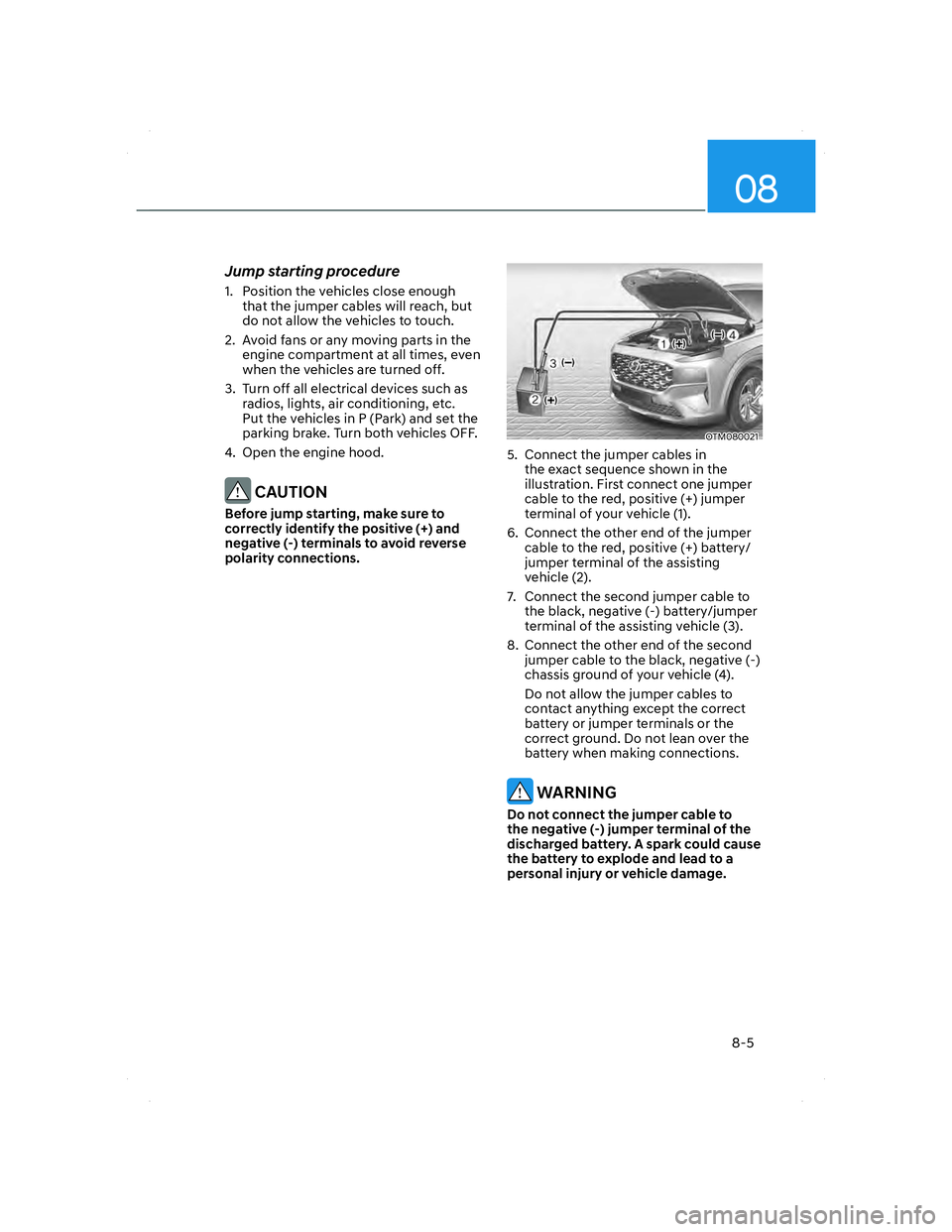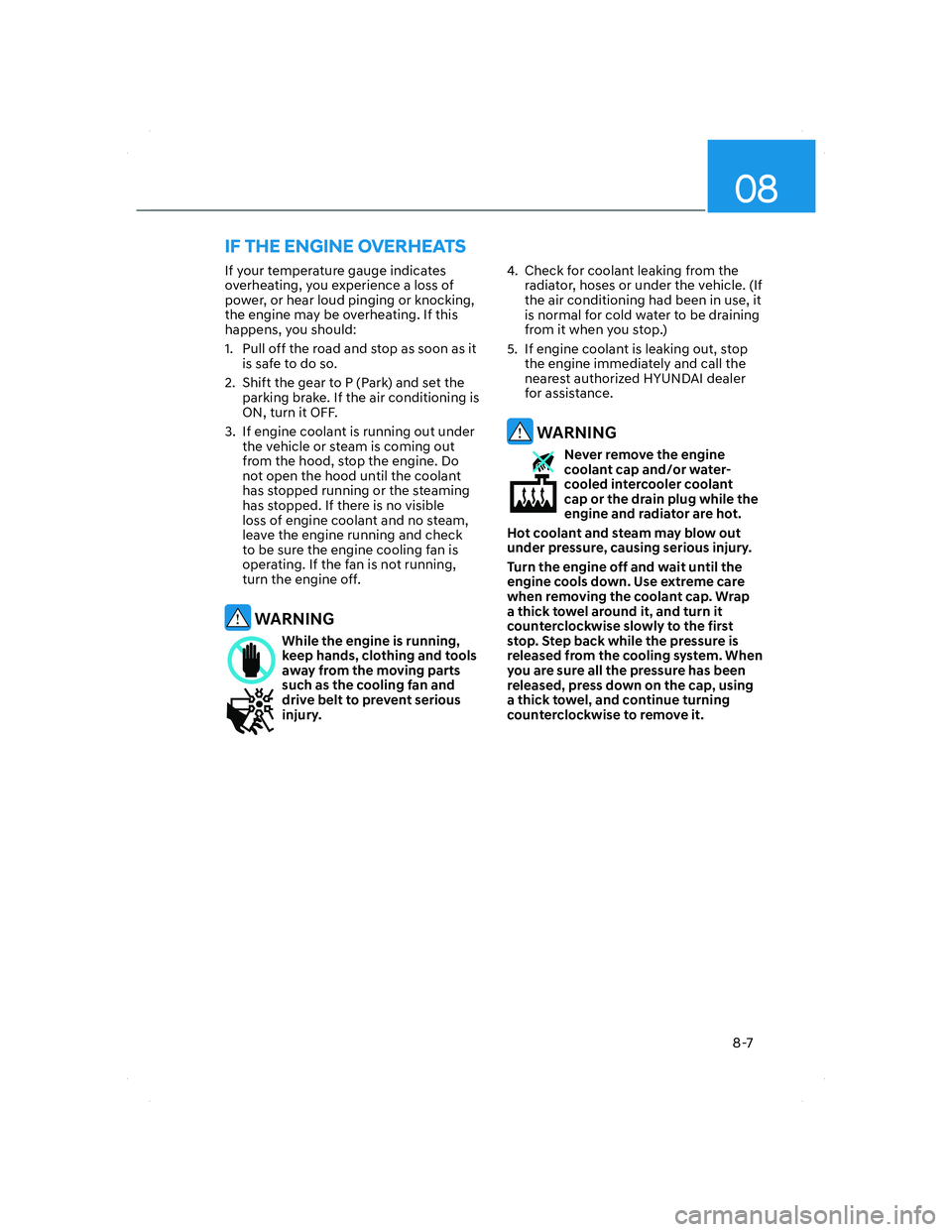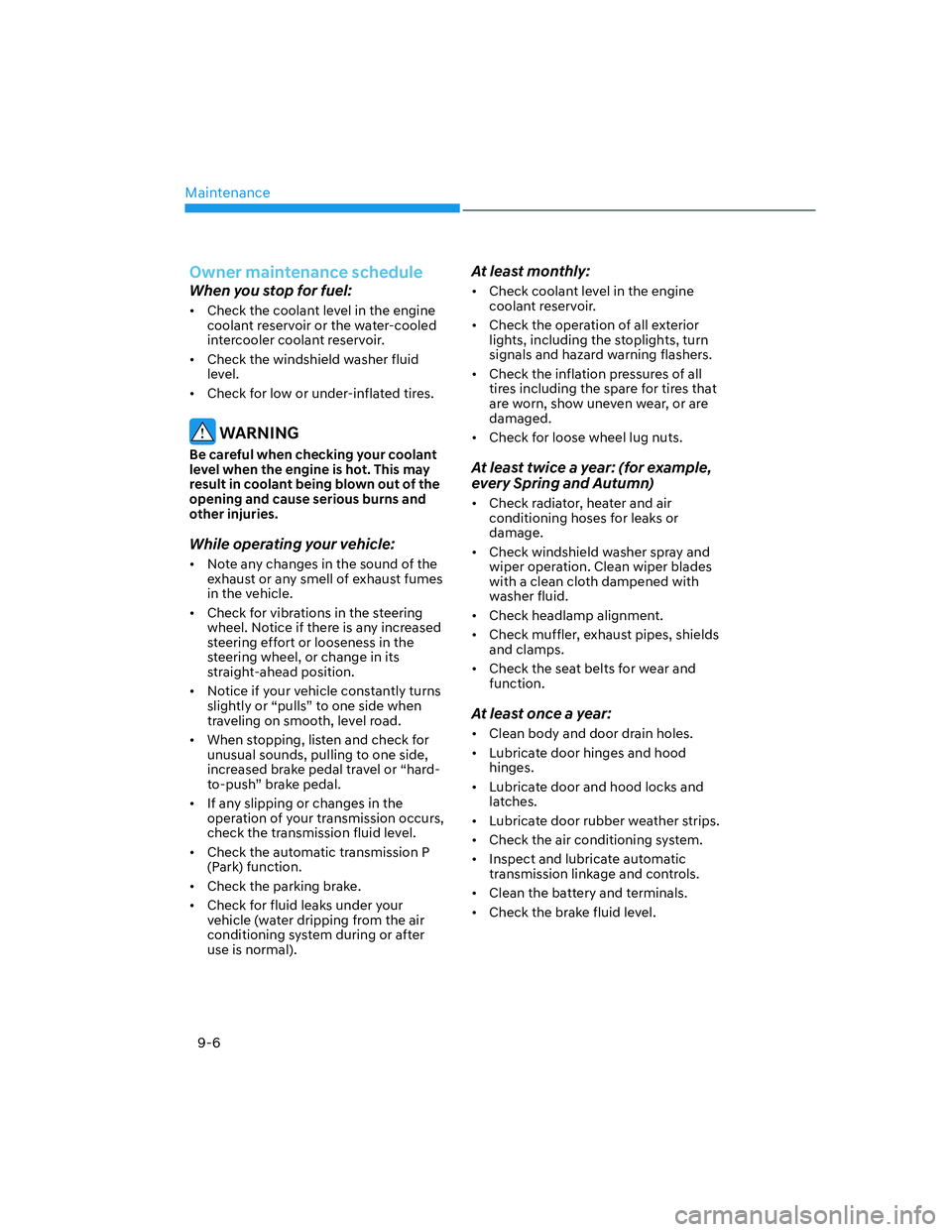Page 520 of 637

08
8-5
Jump starting procedure
1. Position the vehicles close enough
that the jumper cables will reach, but
do not allow the vehicles to touch.
2. Avoid fans or any moving parts in the
engine compartment at all times, even
when the vehicles are turned off.
3. Turn off all electrical devices such as
radios, lights, air conditioning, etc.
Put the vehicles in P (Park) and set the
parking brake. Turn both vehicles OFF.
4. Open the engine hood.
CAUTION
Before jump starting, make sure to
correctly identify the positive (+) and
negative (-) terminals to avoid reverse
polarity connections.
OTM080021OTM080021
5. Connect the jumper cables in
the exact sequence shown in the
illustration. First connect one jumper
cable to the red, positive (+) jumper
terminal of your vehicle (1).
6. Connect the other end of the jumper
cable to the red, positive (+) battery/
jumper terminal of the assisting
vehicle (2).
7. Connect the second jumper cable to
the black, negative (-) battery/jumper
terminal of the assisting vehicle (3).
8. Connect the other end of the second
jumper cable to the black, negative (-)
chassis ground of your vehicle (4).
Do not allow the jumper cables to
contact anything except the correct
battery or jumper terminals or the
correct ground. Do not lean over the
battery when making connections.
WARNING
Do not connect the jumper cable to
the negative (-) jumper terminal of the
discharged battery. A spark could cause
the battery to explode and lead to a
personal injury or vehicle damage.
008_TMa_HMA.indd 8-52021-08-27 1:44:00
Page 522 of 637

08
8-7
If your temperature gauge indicates
overheating, you experience a loss of
power, or hear loud pinging or knocking,
the engine may be overheating. If this
happens, you should:
1. Pull off the road and stop as soon as it
is safe to do so.
2. Shift the gear to P (Park) and set the
parking brake. If the air conditioning is
ON, turn it OFF.
3. If engine coolant is running out under
the vehicle or steam is coming out
from the hood, stop the engine. Do
not open the hood until the coolant
has stopped running or the steaming
has stopped. If there is no visible
loss of engine coolant and no steam,
leave the engine running and check
to be sure the engine cooling fan is
operating. If the fan is not running,
turn the engine off.
WARNING
While the engine is running,
keep hands, clothing and tools
away from the moving parts
such as the cooling fan and
drive belt to prevent serious
injury.4. Check for coolant leaking from the
radiator, hoses or under the vehicle. (If
the air conditioning had been in use, it
is normal for cold water to be draining
from it when you stop.)
5. If engine coolant is leaking out, stop
the engine immediately and call the
nearest authorized HYUNDAI dealer
for assistance.
WARNING
Never remove the engine
coolant cap and/or water-
cooled intercooler coolant
cap or the drain plug while the
engine and radiator are hot.
Hot coolant and steam may blow out
under pressure, causing serious injury.
Turn the engine off and wait until the
engine cools down. Use extreme care
when removing the coolant cap. Wrap
a thick towel around it, and turn it
counterclockwise slowly to the first
stop. Step back while the pressure is
released from the cooling system. When
you are sure all the pressure has been
released, press down on the cap, using
a thick towel, and continue turning
counterclockwise to remove it.
IF THE ENGINE OVERHEATS
008_TMa_HMA.indd 8-72021-08-27 1:44:01
Page 551 of 637

Maintenance
9-6
Owner maintenance schedule
When you stop for fuel:
�[��Check the coolant level in the engine
coolant reservoir or the water-cooled
intercooler coolant reservoir.
�[��Check the windshield washer fluid
level.
�[��Check for low or under-inflated tires.
WARNING
Be careful when checking your coolant
level when the engine is hot. This may
result in coolant being blown out of the
opening and cause serious burns and
other injuries.
While operating your vehicle:
�[��Note any changes in the sound of the
exhaust or any smell of exhaust fumes
in the vehicle.
�[��Check for vibrations in the steering
wheel. Notice if there is any increased
steering effort or looseness in the
steering wheel, or change in its
straight-ahead position.
�[��Notice if your vehicle constantly turns
slightly or “pulls” to one side when
traveling on smooth, level road.
�[��When stopping, listen and check for
unusual sounds, pulling to one side,
increased brake pedal travel or “hard-
to-push” brake pedal.
�[��If any slipping or changes in the
operation of your transmission occurs,
check the transmission fluid level.
�[��Check the automatic transmission P
(Park) function.
�[��Check the parking brake.
�[��Check for fluid leaks under your
vehicle (water dripping from the air
conditioning system during or after
use is normal).
At least monthly:
�[��Check coolant level in the engine
coolant reservoir.
�[��Check the operation of all exterior
lights, including the stoplights, turn
signals and hazard warning flashers.
�[��Check the inflation pressures of all
tires including the spare for tires that
are worn, show uneven wear, or are
damaged.
�[��Check for loose wheel lug nuts.
At least twice a year: (for example,
every Spring and Autumn)
�[��Check radiator, heater and air
conditioning hoses for leaks or
damage.
�[��Check windshield washer spray and
wiper operation. Clean wiper blades
with a clean cloth dampened with
washer fluid.
�[��Check headlamp alignment.
�[��Check muffler, exhaust pipes, shields
and clamps.
�[��Check the seat belts for wear and
function.
At least once a year:
�[��Clean body and door drain holes.
�[��Lubricate door hinges and hood
hinges.
�[��Lubricate door and hood locks and
latches.
�[��Lubricate door rubber weather strips.
�[��Check the air conditioning system.
�[��Inspect and lubricate automatic
transmission linkage and controls.
�[��Clean the battery and terminals.
�[��Check the brake fluid level.
Page:
< prev 1-8 9-16 17-24